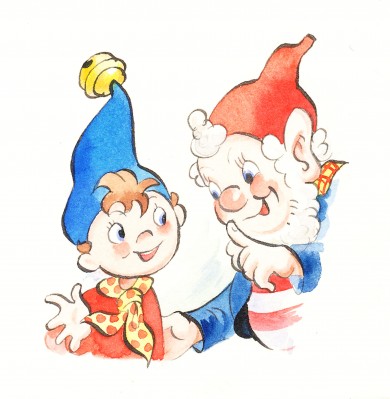Week 1 – Children’s Book Design
Enid Blyton
I have chosen to analyse Enid Blyton and some of her most famous books for this exercise. I chose her as I have fond memories of her books from my own childhood, particularly Noddy and the Famous Five which I will look at in a little more detail.
- As Blyton was a writer foremost, she worked with a number of illustrators when realising the characters from her books.
- Since the Blyton texts mainly used very simple language, the work of the illustrators was an important part of the appeal of many of the works.
The two books, or rather series of books, that I have chosen are Noddy and the Famous Five.
Noddy
- Harmsen van der Beek was a Dutch illustrator and commercial artist who was commissioned to work with Blyton on the creation of Noddy.
- The result was the creation of the Noddy series for young children, authored by Enid Blyton – still a major property for animators half a century later. Van der Beek simply signed his work as “Beek”.
- The conscious intention to create a Disney-style sympathetic focus character — a European Mickey Mouse — was reportedly a major factor.
- Beek’s death in 1953 led to a few new illustrators for the Noddy books, amongst which was his assistant Peter Wienk.
The Famous Five
- Eileen Soper (1905–1990) illustrated around 50 Blyton books, including the whole Famous Five series.
- In the 1970s her illustrations for the Famous Five books were replaced with more contemporary ones by Betty Maxey.
Art Style
To keep the content of this post concise, I will concentrate mainly on the art style featured in the Noddy books, illustrated by Harmsen van der Beek (Beek).
- The original artwork style is very soft and warm.
- Charicature is happy and smiley, with bold colours.
- Media used appears to be mostly watercolour and ink.
- It is quite traditional in it’s approach and is definately of it’s time.
- Iconic and instantly recognisable.
- Cartoony in style.
- Content has become controversial and politically incorrect over time, for example Golliwogs, also Big Ears as it pokes fun at a physical imperfection.
Age group
The books were aimed at young children and would have been read and enjoyed with a parent as a bonding and educational experience. They can however been enjoyed equally by older children, thanks in part to the illustration style. There was often a lot going on in the illustrations, inviting the reader to spend time looking for and finding things they have missed first time.
Due to the controversial nature of some of the characters and the fact that the books are no longer considered politically correct, the content was forced to be updated to meet the 20th century.





